
|   |

|   |
5th Guru Deba Prasad Das Award Festival - Dr. Sunil Kothari e-mail: sunilkothari1933@gmail.com Photos: Ganesh Sahoo January 30, 2012
By a happy coincidence, no sooner did Raja Rani Music Festival conclude at Bhubaneswar, then followed 5th Guru Deba Prasad Das Award Festival on 23rd and 24th January 2012, organized for the past five years by the indefatigable disciple Gajendra Panda, who carries on late Guru Deba Prasad Das's legacy with deep sincerity. The first award (2007) was given to Guru Mayadhar Raut, a contemporary of Guru Deba Prasad Das, who along with Deba Prasad Das and the other two legendary gurus Pankaj Charan Das and Kelucharan Mohapatra, contributed immensely in shaping the Odissi dance form. The second award (2008) was given to Guru Durlava Chandra Singh of Puri, followed by 3rd award (2009) to Guru Raghunath Dutta who taught for several years at Kala Vikash Kendra. The fourth award last year (2010) was given to Yamini Krishnamurti, a redoubtable legendary dancer and a disciple of Guru Pankaj Charan Das. For the 5th year, the award for 2011 was given to senior most Odissi exponent Dr. Minati Mishra who in her early eighties, amazes onlookers by her command over the technique, the stillness in her postures, and the yogic quality of her dance. She served Utkal Sangeet Mahavidyalaya as a Principal for many years. Both Guru Pankaj Charan Das and Guru Deba Prasad Das taught at Utkal Sangeet Mahavidyalaya, giving benefit of their individual styles to young generation of gurus and exponents including late Guru Gangadhar Pradhan. Dr. Minati Mishra also studied some numbers from both the gurus. The evening started dot on time, since the Principal Secretary of Tourism and Culture, Mr. Ashok Kumar Tripathy, encourages starting events on time. Gajendra spoke briefly about the festival. Mr. Tripathy complimented him and assured him full support to make it a part of the cultural calendar and spoke about the various other attractions for tourism, what he learnt in the process and dovetailed all those experiences and learning into practice. I was asked to say a few words about Guru Deba Prasad Das, on account of my long association with the Guru. I had seen him for the first time at All India Dance Seminar held by Sangeet Natak Akademi at Vigyan Bhavan in Delhi in April 1958, when Kavi Chandra Kalicharan Patanaik, the celebrated Odiya poet, dramatist, actor, scholar had presented a paper tracing the history of Odissi dance and young Guru Deba Prasad Das had demonstrated the salient features of Odissi with chauka, tribhanga and various body movements, with indescribable beauty, casting a spell on the galaxy of great dance gurus, performers, scholars, rasikas, connoisseurs, drawing attention to the beauty of Odissi dance. Another young dancer by name Jayanti Ghosh, (she passed away last year) had also performed a few numbers opening the eyes of those present to the exposition of Odissi. 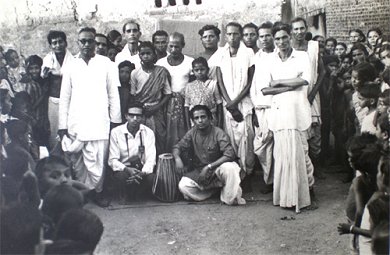 Sunil Kothari and Guru Deba Prasad Das sitting. Pic taken at Kumbharia village for field work and research on Sabdaswarapata (1966) 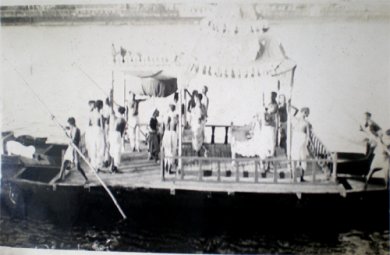 At Chandan Jatra when a gotipua danced on boat and Guru Pankaj Charan Das played pakhavaj. After a few years the tradition was discontinued (May 1966) Photo: Dhiraj Chavda Since then I was close to Deba Prasad Das. And over the years that I spent researching Odissi, visiting Odisha regularly, I kept in touch with him. For field work, he accompanied me to Kumbharia village in Sambalpur for recording and photographing Sabdaswarapata tradition and compositions of which he was a master and a treasure trove. At Vajreshwari temple, an old exponent demonstrated various Sabdaswarapata compositions for us. Some are known as pallavis and I am told there are more than 30 of them which still need to be recorded. We had walked a lot to reach the village, crossing river and fields. I shall never forget those days and his assistance. I have devoted a chapter to Sabdaswarapata in my Marg book on Odissi (1990) giving due credit to Guru Deba Prasad Das. In 1984, Madhavi Mudgal and Gandharva Maha Vidyalaya held a historic conference on Odissi titled 'Angahara' in Delhi. I had once again gone to Bhubaneswar and spent some time with Deba Prasad Das. His prime disciple Vijaylakshmi used to perform Bandha Nrtiya. Those rare movements have been captured by my painter and poet friend Gulam Mohammed Sheikh in exquisite photographs in the Marg book on Odissi. Deba Prasad Das had brought his prize pupil Sujata Mishra to perform at Angahara. Her performance was hailed by one and all as excellent. In my review of Angahara festival in India Today, her photo was published. Like a Lakshmi arising from waters, Sujata with her dignified personality and presence had drawn attention of one and all. Deba Prasad Das was very happy at the accolades he received from cognoscenti and his admirers. He had trained Indrani Rahman who indeed put Odissi on the world map. Guru Deba Prasad had travelled abroad and contributed in popularizing Odissi. His own signature on Odissi in terms of his choreographic works, use of Sabdaswarapata and several songs he loved are a blessing for younger generation to emulate. I have been a great admirer of Deba Prasad Das. 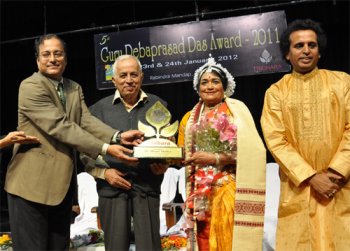 Ashok Kumar Tripathy (Principal Secretary of Tourism and Culture), Satakadi Hota (ed of Samay), Minati Mishra, Gajendra Panda  Minati Mishra To pay tribute to Guru Deba Prasad Das, awardee Minati Mishra performed two numbers of which the first one was choreographed by Guru Deba Prasad Das. "Ambadhava rachayati tandava nata prakat" goes the refrain in praise of Lord Shiva, husband of Amba - Parvati. Guru Deba Prasad Das's contribution in bringing Shaivite compositions within the fold of Odissi is noteworthy. Minati evoked the feeling with her stillness and perfect bhanga - body position, bending without any effort. Practice of years has given her this quality. Followed by her own choreography of Nirvikalpa Sutra containing deep philosophical content: "Manobuddhyanka ahamkara chittanetinaham, na cha shrotra na cha jihva... na cha netra, na cha vyoma, na cha bhumi na cha teja, na cha vayu…" and so on extolling Lord Shiva's form 'Shivoham Shivoham.' Employing tantric hasta mudras, holding at the back, Minati seemed lost in dhyana, meditation of Shivoham Shivoham. Ramli Ibrahim, a disciple of Guru Deba Prasad Das, specially returned to Bhubaneswar to pay homage to his guru. Ramli has received enough praise and it is like gilding a lily to shower encomiums on him. I went the previous evening to Gajendra Panda's residence at Tridhara school to watch rehearsal by Ramli. And what a pleasure it was to see his repertoire, early choreographic works of Deba Prasad Das. Right from prayer 'Manglam Bhagwan Vishnu' to the following nritta piece sabhinaya pallavi in Kalavati, there was an old world charm in his execution of dance as taught to him by Deba Prasad Das. There is a joyous approach in that evergreen song 'sangini chanha venupaniki', admiring Lord's beauty, and Indrani Rahman used to perform it. Ramli's performance evoked wonderful memories. Ramli registers bhavas, expressions competently and invests them with a feeling of joy, losing himself while performing. The dynamic images linger long in memory. 'Ashta Shambho,' another gem of Deba Prasad Das revealed Lord Shiva's various forms. One noteworthy image was when Lord Shiva picks up the body of Sati from the fire after she immolates in the yagnakunda at Daksha's yagna where she goes uninvited. The art of suggestion that Deba Prasad Das employed enhances the impact of the number. For me these numbers were like visiting old friends again and appreciate, relish the beauty of choreographic works of Deba Prasad Das. It was indeed heartening to see Ramli remaining steadfast to his Guru's compositions. The musicians gave him admirable support. Sukant Kundu's singing was soulful and Dhaneswar Swain on mardala added another dimension. 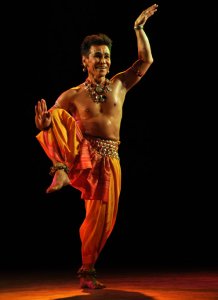 Ramli Ibrahim 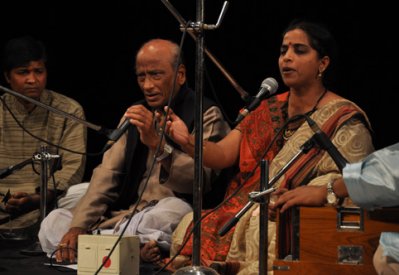 Guru Gopal Chandra Panda and his daughter The Odissi music vocal recital by Guru Pt Gopal Chandra Panda, Central Sangeet Natak Akademi awardee and his daughter was another highlight of the event. Guru Gopal Chandra Panda had worked in close collaboration with Guru Deba Prasad Das and composed music for his dance numbers. Deba Prasad sought his guidance in Odissi music. With advancing age of course, Guru Gopal Panda's voice seemed under cloud, but the way he demonstrated nuances, which were reproduced by his daughter, were excellent, giving Odissi music its own individuality. His rendering of Bhajuki Ramanama Govinda was full of bhakti bhava. Several of the songs he rendered reflected his authority. He is like a national treasure. Gajendra Panda must be commended for bringing him on stage as it emphasized the close relation between dancer Guru Deba Prasad Das and musician Guru Gopal Panda. 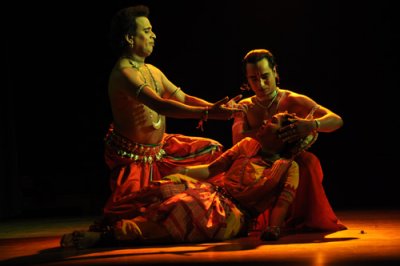

As finale, Gajendra Panda presented Sankshipta Ramayana, which indeed is an engaging choreographic work. Gajendra with his trained dancers and son playing role of golden deer has packed in lot of dramatic events. However, since the performances in the evening appeared crowded, the presentation would have gained better response with an edited version. Gajendra is a gifted dancer and has learnt a lot from Deba Prasad Das and is fortunate to master the art and also transmit it to others. On the second day, Minati reminisced about Deba Prasad Das and Ramli also paid tribute. The evening took off with Reela Hota's solo and then a duet with Sudarshan Sahoo. Reela has an attractive stage presence and a fine figure for sculpturesque Odissi images. She has made deep study of Tantra and has incorporated theme of Kundalini imaginatively. The text she used for dance has excellent epithets. Awakening of Kundalini, muladhar chakra etc have significant meaning in Tantra. In duet, Reela and Sudarshan Sahoo positioned in a manner which created image of chaturbhuja, four armed icon. The yogic sarpa mudra and 'sarva mangalam,' the blowing of conch - shankha dhwani were arresting. Sudarshan Sahoo has good male stage presence. 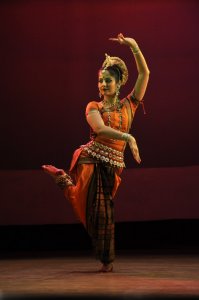 Reela Hota 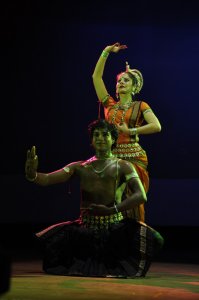 Reela Hota and Sudarshan Sahoo However, the projection on part of Reela appeared weak. Reela would benefit a lot from concentrating on how to project herself in an arresting manner. The moment a dancer enters the stage, some manage to capture attention of the audience immediately. It is a strategy and she would do well to use it. The music was recorded and needs also proper sync.
Kala Krishna, a brilliant exponent of Andhra Natyam from Hyderabad is a legend for his impersonation of female role, in particular of Satyabhama in Nava Janardhana Parijatam theme. Performed in Kunti Madhav temple, this unique dance is captivating. What with complete metamorphosis of a male into female, making one marvel at such 'parakaya pravesh,' entering into another body, woman's temperament, graceful gestures, fleeting expressions, face registering them with ease and to Rama's melodious singing, Kala Krishna cast a spell on the audience. When Satyabhama is in separation, blames moon (Chandradushanam - singing Chandamama, Chandamama) and Ramaiyya Ramaiyya refrain, lilting Dadhi mathana lyrics, he rose to great heights. But the most remarkable was the letter Satyabhama wrote to Krishna and recited with several gestures offering countless pranams, salutations - it was the highlight of the presentation. He deserves to be seen more often in Odisha. A memorable performance. 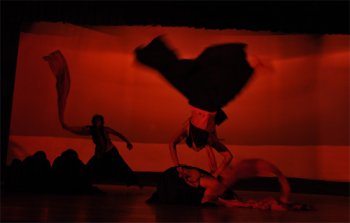
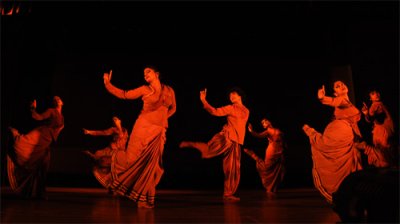
From Kolkata, Tanushree Shankar brought 'Chirantan,' a choreographic work in modern format with her distinct style. The narration was by none else than Amitabh Bachchan with his baritone voice. Music was by Debjyoti Mishra and Tanushree's dancers performed in a seamless manner. The coordination was as per her fame she has won and flawless. The theme is peace in this world of chaos with distinct use of Gurudev Tagore's songs, highlighting the entire presentation. The male dancers leapt up in the air with skills of trapeze dancers, female dancers performed with grace and intensity; the large movements typical of Uday Shankar inspired style had great appeal. Tanushree's choreography engaged audience from the word go. So refreshing and different from classical dance forms, the production brought a whiff of fresh air. She won hands down and audience cheered all dancers with rounds of applause. Professional, imaginative and full of appeal with a timely message, 'Chirantan' left an indelible mark. The two day festival in memory of Guru Deba Prasad Das deserves full support from one and all lovers of tradition to keep the memory of this great guru alive. Gajendra Panda deserves congratulations for his Herculean efforts. With more attention to organizational problems, Gajendra would receive more success. His dedication is exemplary. Here's wishing him all the best in all his endeavours.  Dr. Sunil Kothari is a dance historian, scholar, author and a renowned dance critic. He is Vice President of World Dance Alliance Asia Pacific India chapter, based in New Delhi. He is honored by the President of India with Padma Shri, Sangeet Natak Akademi award and Senior Critic Award from Dance Critics Association, NYC. He is a regular contributor to www.narthaki.com, the roving critic for monthly magazine Sruti and is a contributing editor of Nartanam for the past 11 years. Post your comments Pl provide your name and email id along with your comment. All appropriate comments posted with name and email id in the blog will also be featured in the site. |